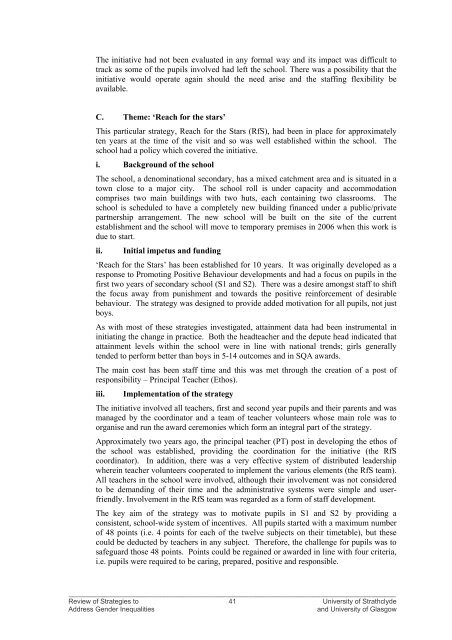Review of Strategies to Address Gender Inequalities in Scottish ...
Review of Strategies to Address Gender Inequalities in Scottish ...
Review of Strategies to Address Gender Inequalities in Scottish ...
You also want an ePaper? Increase the reach of your titles
YUMPU automatically turns print PDFs into web optimized ePapers that Google loves.
The <strong>in</strong>itiative had not been evaluated <strong>in</strong> any formal way and its impact was difficult <strong>to</strong>track as some <strong>of</strong> the pupils <strong>in</strong>volved had left the school. There was a possibility that the<strong>in</strong>itiative would operate aga<strong>in</strong> should the need arise and the staff<strong>in</strong>g flexibility beavailable.C. Theme: ‘Reach for the stars’This particular strategy, Reach for the Stars (RfS), had been <strong>in</strong> place for approximatelyten years at the time <strong>of</strong> the visit and so was well established with<strong>in</strong> the school. Theschool had a policy which covered the <strong>in</strong>itiative.i. Background <strong>of</strong> the schoolThe school, a denom<strong>in</strong>ational secondary, has a mixed catchment area and is situated <strong>in</strong> a<strong>to</strong>wn close <strong>to</strong> a major city. The school roll is under capacity and accommodationcomprises two ma<strong>in</strong> build<strong>in</strong>gs with two huts, each conta<strong>in</strong><strong>in</strong>g two classrooms. Theschool is scheduled <strong>to</strong> have a completely new build<strong>in</strong>g f<strong>in</strong>anced under a public/privatepartnership arrangement. The new school will be built on the site <strong>of</strong> the currentestablishment and the school will move <strong>to</strong> temporary premises <strong>in</strong> 2006 when this work isdue <strong>to</strong> start.ii. Initial impetus and fund<strong>in</strong>g‘Reach for the Stars’ has been established for 10 years. It was orig<strong>in</strong>ally developed as aresponse <strong>to</strong> Promot<strong>in</strong>g Positive Behaviour developments and had a focus on pupils <strong>in</strong> thefirst two years <strong>of</strong> secondary school (S1 and S2). There was a desire amongst staff <strong>to</strong> shiftthe focus away from punishment and <strong>to</strong>wards the positive re<strong>in</strong>forcement <strong>of</strong> desirablebehaviour. The strategy was designed <strong>to</strong> provide added motivation for all pupils, not justboys.As with most <strong>of</strong> these strategies <strong>in</strong>vestigated, atta<strong>in</strong>ment data had been <strong>in</strong>strumental <strong>in</strong><strong>in</strong>itiat<strong>in</strong>g the change <strong>in</strong> practice. Both the headteacher and the depute head <strong>in</strong>dicated thatatta<strong>in</strong>ment levels with<strong>in</strong> the school were <strong>in</strong> l<strong>in</strong>e with national trends; girls generallytended <strong>to</strong> perform better than boys <strong>in</strong> 5-14 outcomes and <strong>in</strong> SQA awards.The ma<strong>in</strong> cost has been staff time and this was met through the creation <strong>of</strong> a post <strong>of</strong>responsibility – Pr<strong>in</strong>cipal Teacher (Ethos).iii. Implementation <strong>of</strong> the strategyThe <strong>in</strong>itiative <strong>in</strong>volved all teachers, first and second year pupils and their parents and wasmanaged by the coord<strong>in</strong>a<strong>to</strong>r and a team <strong>of</strong> teacher volunteers whose ma<strong>in</strong> role was <strong>to</strong>organise and run the award ceremonies which form an <strong>in</strong>tegral part <strong>of</strong> the strategy.Approximately two years ago, the pr<strong>in</strong>cipal teacher (PT) post <strong>in</strong> develop<strong>in</strong>g the ethos <strong>of</strong>the school was established, provid<strong>in</strong>g the coord<strong>in</strong>ation for the <strong>in</strong>itiative (the RfScoord<strong>in</strong>a<strong>to</strong>r). In addition, there was a very effective system <strong>of</strong> distributed leadershipwhere<strong>in</strong> teacher volunteers cooperated <strong>to</strong> implement the various elements (the RfS team).All teachers <strong>in</strong> the school were <strong>in</strong>volved, although their <strong>in</strong>volvement was not considered<strong>to</strong> be demand<strong>in</strong>g <strong>of</strong> their time and the adm<strong>in</strong>istrative systems were simple and userfriendly.Involvement <strong>in</strong> the RfS team was regarded as a form <strong>of</strong> staff development.The key aim <strong>of</strong> the strategy was <strong>to</strong> motivate pupils <strong>in</strong> S1 and S2 by provid<strong>in</strong>g aconsistent, school-wide system <strong>of</strong> <strong>in</strong>centives. All pupils started with a maximum number<strong>of</strong> 48 po<strong>in</strong>ts (i.e. 4 po<strong>in</strong>ts for each <strong>of</strong> the twelve subjects on their timetable), but thesecould be deducted by teachers <strong>in</strong> any subject. Therefore, the challenge for pupils was <strong>to</strong>safeguard those 48 po<strong>in</strong>ts. Po<strong>in</strong>ts could be rega<strong>in</strong>ed or awarded <strong>in</strong> l<strong>in</strong>e with four criteria,i.e. pupils were required <strong>to</strong> be car<strong>in</strong>g, prepared, positive and responsible.______________________________________________________________________________________<strong>Review</strong> <strong>of</strong> <strong>Strategies</strong> <strong>to</strong> 41 University <strong>of</strong> Strathclyde<strong>Address</strong> <strong>Gender</strong> <strong>Inequalities</strong>and University <strong>of</strong> Glasgow
















